Financial Accounting Case Study: Sunshine Ltd Analysis
VerifiedAdded on 2020/05/28
|10
|2863
|70
Case Study
AI Summary
This case study delves into the financial accounting practices of Sunshine Ltd, examining the manipulation of depreciation methods by the General Manager, Kam Sunshine, and the ethical dilemmas faced by the accountant, Maria Mars. The case explores the shift from straight-line to sum-of-years-digits depreciation, its impact on reported profits, and the implications for stakeholders including shareholders, creditors, suppliers, and customers. It analyzes the effects of Australian Accounting Standards Board (AASB) 116 on property, plant, and equipment accounting, highlighting issues of asset realization, carrying amounts, depreciation, and impairment losses. The study also addresses corporate governance failures, lack of transparency, and ethical breaches. The case study provides a detailed analysis of depreciation techniques and their financial implications within the context of the Sunshine Ltd case, offering valuable insights into financial reporting and ethical considerations.
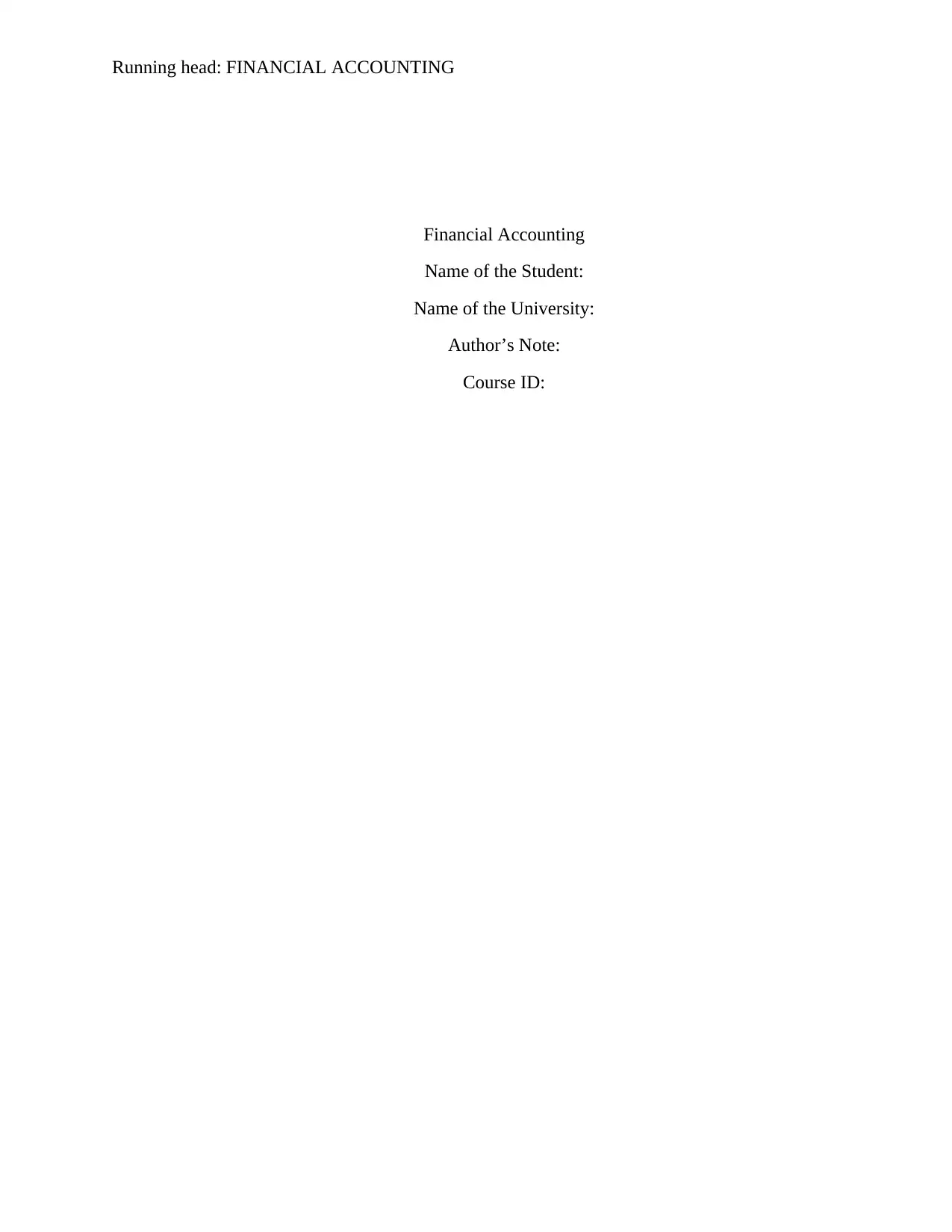
Running head: FINANCIAL ACCOUNTING
Financial Accounting
Name of the Student:
Name of the University:
Author’s Note:
Course ID:
Financial Accounting
Name of the Student:
Name of the University:
Author’s Note:
Course ID:
Paraphrase This Document
Need a fresh take? Get an instant paraphrase of this document with our AI Paraphraser
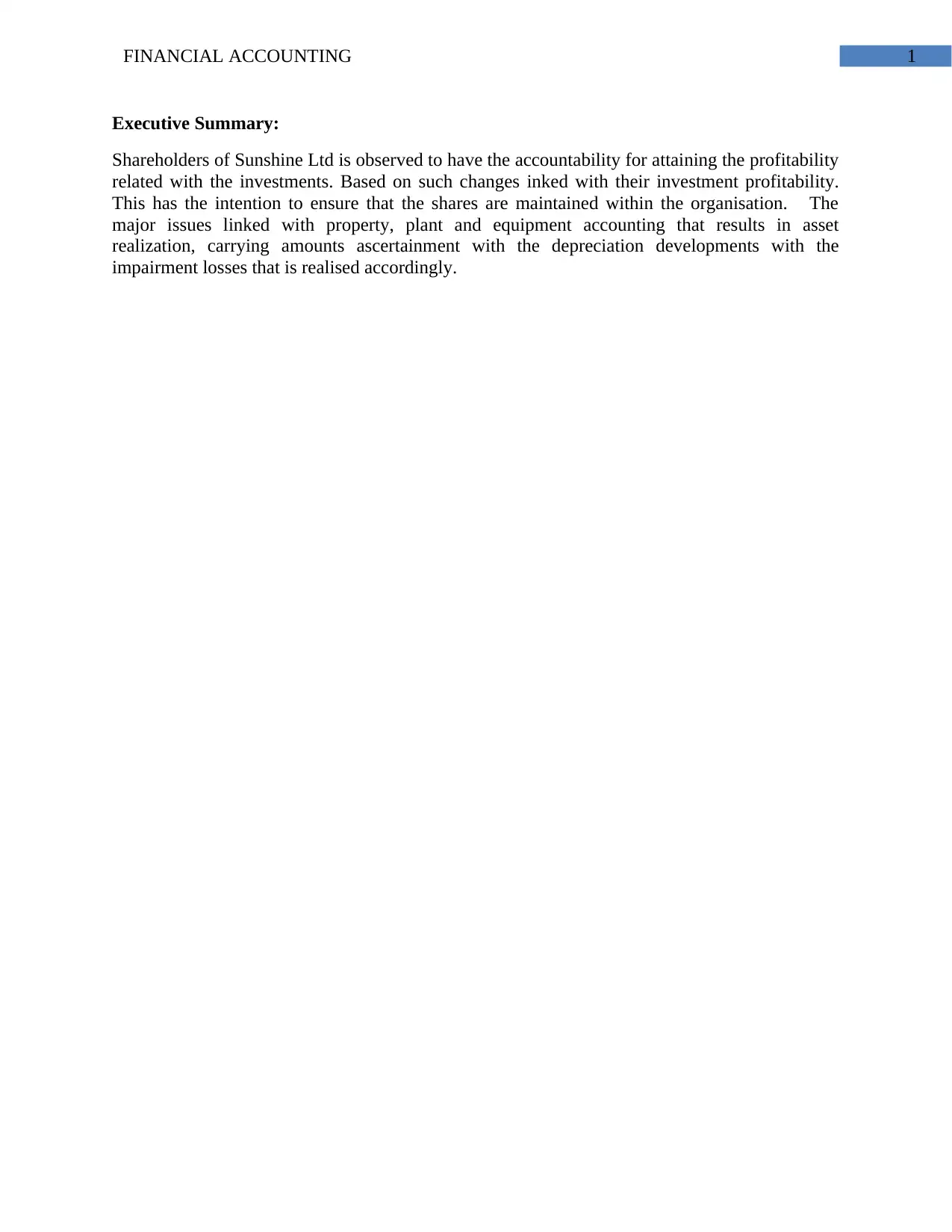
FINANCIAL ACCOUNTING 1
Executive Summary:
Shareholders of Sunshine Ltd is observed to have the accountability for attaining the profitability
related with the investments. Based on such changes inked with their investment profitability.
This has the intention to ensure that the shares are maintained within the organisation. The
major issues linked with property, plant and equipment accounting that results in asset
realization, carrying amounts ascertainment with the depreciation developments with the
impairment losses that is realised accordingly.
Executive Summary:
Shareholders of Sunshine Ltd is observed to have the accountability for attaining the profitability
related with the investments. Based on such changes inked with their investment profitability.
This has the intention to ensure that the shares are maintained within the organisation. The
major issues linked with property, plant and equipment accounting that results in asset
realization, carrying amounts ascertainment with the depreciation developments with the
impairment losses that is realised accordingly.
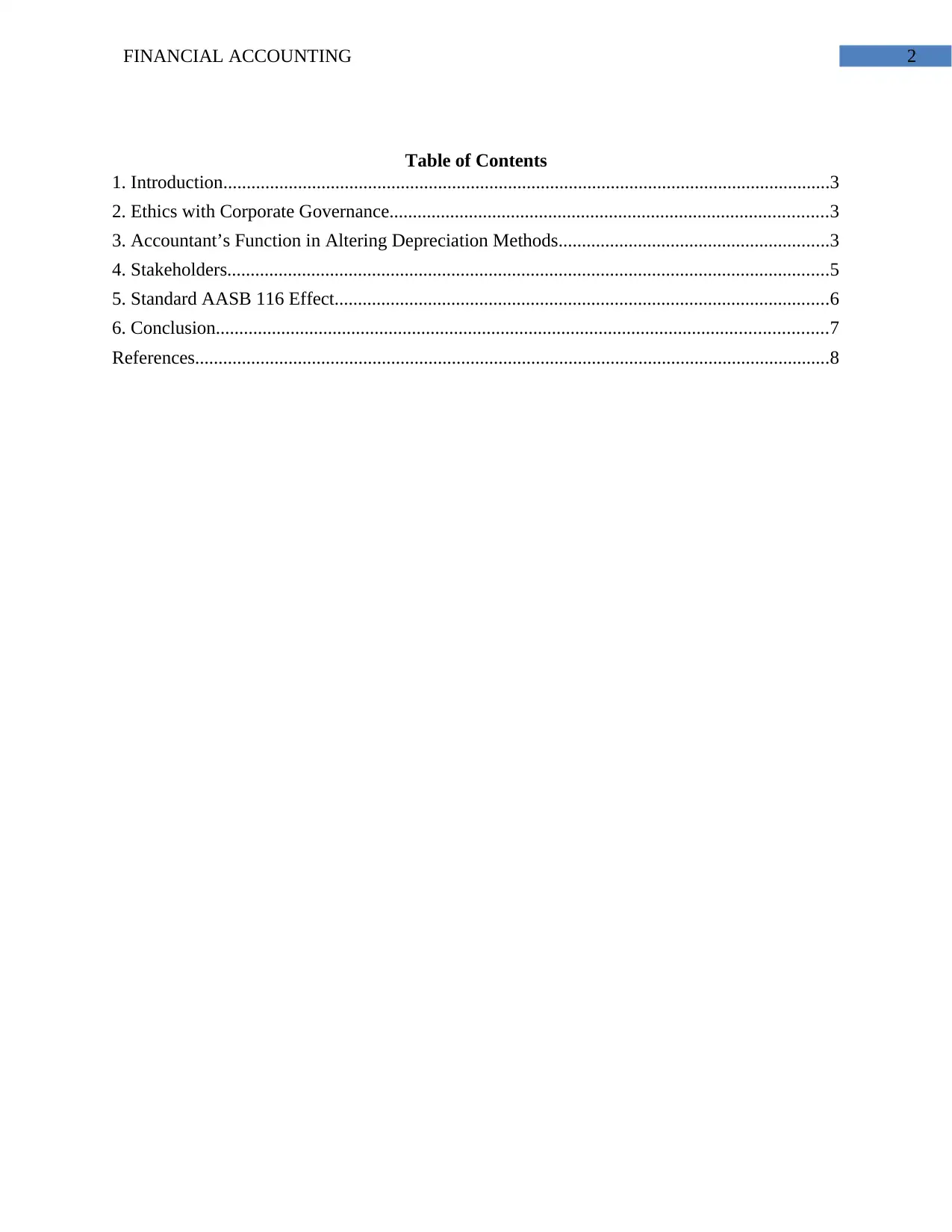
FINANCIAL ACCOUNTING 2
Table of Contents
1. Introduction..................................................................................................................................3
2. Ethics with Corporate Governance..............................................................................................3
3. Accountant’s Function in Altering Depreciation Methods..........................................................3
4. Stakeholders.................................................................................................................................5
5. Standard AASB 116 Effect..........................................................................................................6
6. Conclusion...................................................................................................................................7
References........................................................................................................................................8
Table of Contents
1. Introduction..................................................................................................................................3
2. Ethics with Corporate Governance..............................................................................................3
3. Accountant’s Function in Altering Depreciation Methods..........................................................3
4. Stakeholders.................................................................................................................................5
5. Standard AASB 116 Effect..........................................................................................................6
6. Conclusion...................................................................................................................................7
References........................................................................................................................................8
⊘ This is a preview!⊘
Do you want full access?
Subscribe today to unlock all pages.

Trusted by 1+ million students worldwide
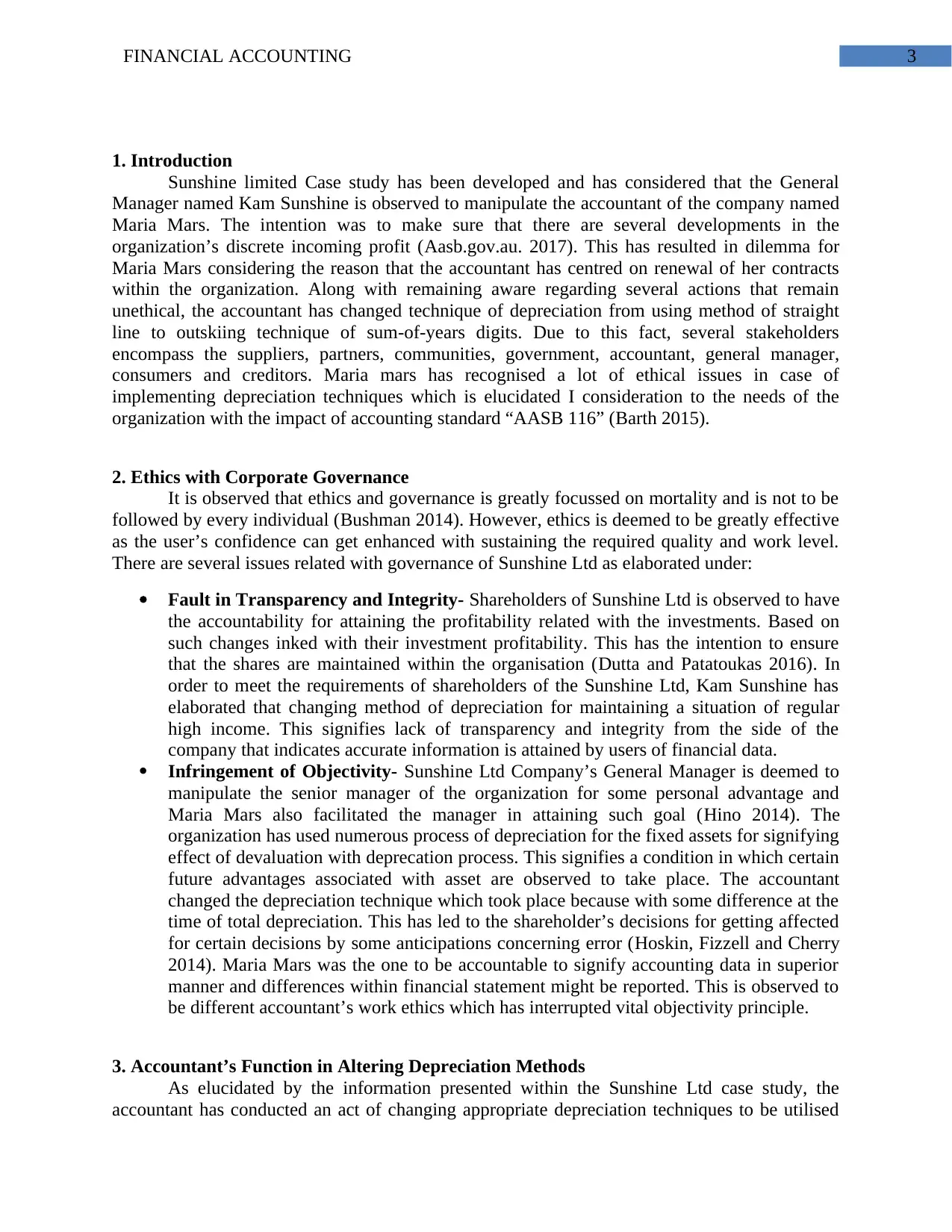
FINANCIAL ACCOUNTING 3
1. Introduction
Sunshine limited Case study has been developed and has considered that the General
Manager named Kam Sunshine is observed to manipulate the accountant of the company named
Maria Mars. The intention was to make sure that there are several developments in the
organization’s discrete incoming profit (Aasb.gov.au. 2017). This has resulted in dilemma for
Maria Mars considering the reason that the accountant has centred on renewal of her contracts
within the organization. Along with remaining aware regarding several actions that remain
unethical, the accountant has changed technique of depreciation from using method of straight
line to outskiing technique of sum-of-years digits. Due to this fact, several stakeholders
encompass the suppliers, partners, communities, government, accountant, general manager,
consumers and creditors. Maria mars has recognised a lot of ethical issues in case of
implementing depreciation techniques which is elucidated I consideration to the needs of the
organization with the impact of accounting standard “AASB 116” (Barth 2015).
2. Ethics with Corporate Governance
It is observed that ethics and governance is greatly focussed on mortality and is not to be
followed by every individual (Bushman 2014). However, ethics is deemed to be greatly effective
as the user’s confidence can get enhanced with sustaining the required quality and work level.
There are several issues related with governance of Sunshine Ltd as elaborated under:
Fault in Transparency and Integrity- Shareholders of Sunshine Ltd is observed to have
the accountability for attaining the profitability related with the investments. Based on
such changes inked with their investment profitability. This has the intention to ensure
that the shares are maintained within the organisation (Dutta and Patatoukas 2016). In
order to meet the requirements of shareholders of the Sunshine Ltd, Kam Sunshine has
elaborated that changing method of depreciation for maintaining a situation of regular
high income. This signifies lack of transparency and integrity from the side of the
company that indicates accurate information is attained by users of financial data.
Infringement of Objectivity- Sunshine Ltd Company’s General Manager is deemed to
manipulate the senior manager of the organization for some personal advantage and
Maria Mars also facilitated the manager in attaining such goal (Hino 2014). The
organization has used numerous process of depreciation for the fixed assets for signifying
effect of devaluation with deprecation process. This signifies a condition in which certain
future advantages associated with asset are observed to take place. The accountant
changed the depreciation technique which took place because with some difference at the
time of total depreciation. This has led to the shareholder’s decisions for getting affected
for certain decisions by some anticipations concerning error (Hoskin, Fizzell and Cherry
2014). Maria Mars was the one to be accountable to signify accounting data in superior
manner and differences within financial statement might be reported. This is observed to
be different accountant’s work ethics which has interrupted vital objectivity principle.
3. Accountant’s Function in Altering Depreciation Methods
As elucidated by the information presented within the Sunshine Ltd case study, the
accountant has conducted an act of changing appropriate depreciation techniques to be utilised
1. Introduction
Sunshine limited Case study has been developed and has considered that the General
Manager named Kam Sunshine is observed to manipulate the accountant of the company named
Maria Mars. The intention was to make sure that there are several developments in the
organization’s discrete incoming profit (Aasb.gov.au. 2017). This has resulted in dilemma for
Maria Mars considering the reason that the accountant has centred on renewal of her contracts
within the organization. Along with remaining aware regarding several actions that remain
unethical, the accountant has changed technique of depreciation from using method of straight
line to outskiing technique of sum-of-years digits. Due to this fact, several stakeholders
encompass the suppliers, partners, communities, government, accountant, general manager,
consumers and creditors. Maria mars has recognised a lot of ethical issues in case of
implementing depreciation techniques which is elucidated I consideration to the needs of the
organization with the impact of accounting standard “AASB 116” (Barth 2015).
2. Ethics with Corporate Governance
It is observed that ethics and governance is greatly focussed on mortality and is not to be
followed by every individual (Bushman 2014). However, ethics is deemed to be greatly effective
as the user’s confidence can get enhanced with sustaining the required quality and work level.
There are several issues related with governance of Sunshine Ltd as elaborated under:
Fault in Transparency and Integrity- Shareholders of Sunshine Ltd is observed to have
the accountability for attaining the profitability related with the investments. Based on
such changes inked with their investment profitability. This has the intention to ensure
that the shares are maintained within the organisation (Dutta and Patatoukas 2016). In
order to meet the requirements of shareholders of the Sunshine Ltd, Kam Sunshine has
elaborated that changing method of depreciation for maintaining a situation of regular
high income. This signifies lack of transparency and integrity from the side of the
company that indicates accurate information is attained by users of financial data.
Infringement of Objectivity- Sunshine Ltd Company’s General Manager is deemed to
manipulate the senior manager of the organization for some personal advantage and
Maria Mars also facilitated the manager in attaining such goal (Hino 2014). The
organization has used numerous process of depreciation for the fixed assets for signifying
effect of devaluation with deprecation process. This signifies a condition in which certain
future advantages associated with asset are observed to take place. The accountant
changed the depreciation technique which took place because with some difference at the
time of total depreciation. This has led to the shareholder’s decisions for getting affected
for certain decisions by some anticipations concerning error (Hoskin, Fizzell and Cherry
2014). Maria Mars was the one to be accountable to signify accounting data in superior
manner and differences within financial statement might be reported. This is observed to
be different accountant’s work ethics which has interrupted vital objectivity principle.
3. Accountant’s Function in Altering Depreciation Methods
As elucidated by the information presented within the Sunshine Ltd case study, the
accountant has conducted an act of changing appropriate depreciation techniques to be utilised
Paraphrase This Document
Need a fresh take? Get an instant paraphrase of this document with our AI Paraphraser
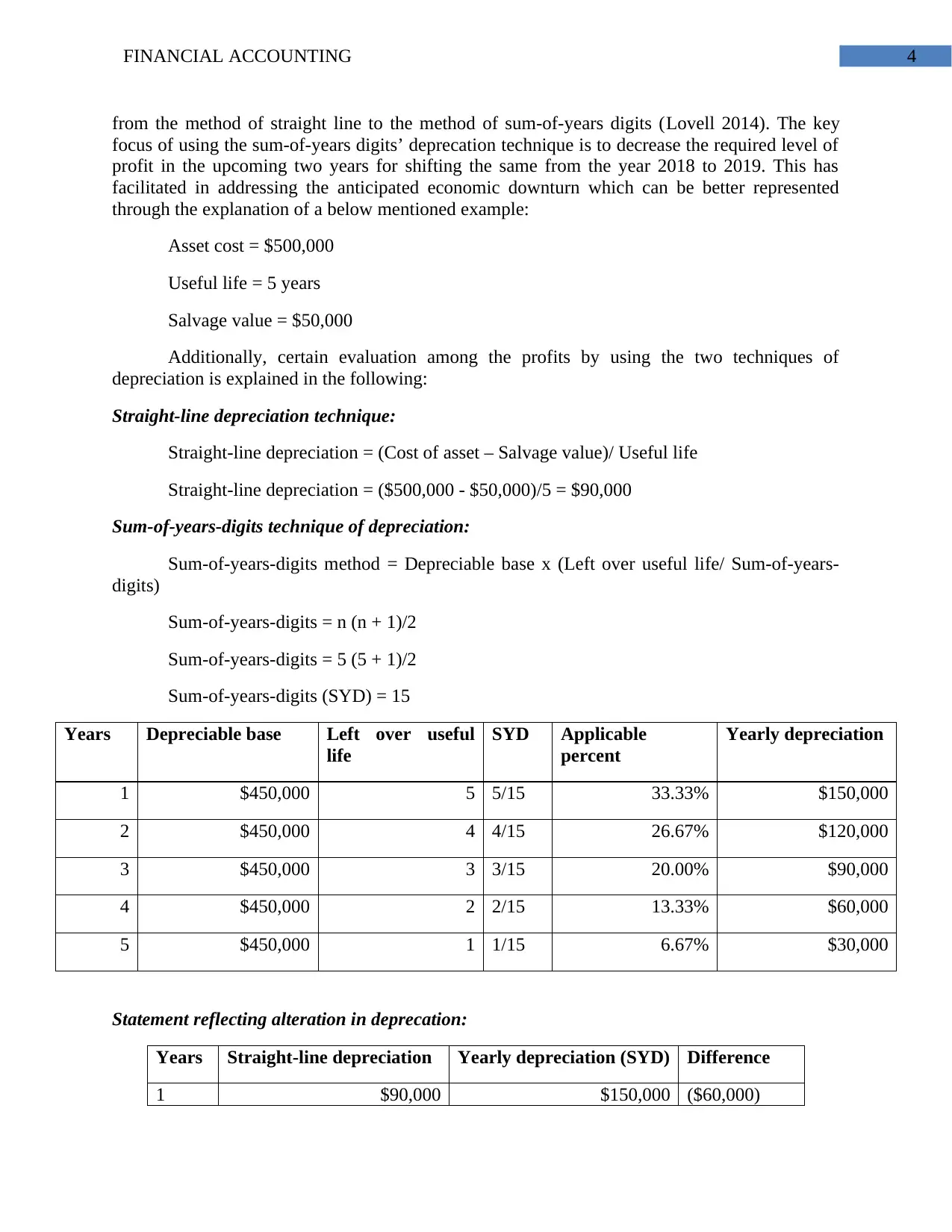
FINANCIAL ACCOUNTING 4
from the method of straight line to the method of sum-of-years digits (Lovell 2014). The key
focus of using the sum-of-years digits’ deprecation technique is to decrease the required level of
profit in the upcoming two years for shifting the same from the year 2018 to 2019. This has
facilitated in addressing the anticipated economic downturn which can be better represented
through the explanation of a below mentioned example:
Asset cost = $500,000
Useful life = 5 years
Salvage value = $50,000
Additionally, certain evaluation among the profits by using the two techniques of
depreciation is explained in the following:
Straight-line depreciation technique:
Straight-line depreciation = (Cost of asset – Salvage value)/ Useful life
Straight-line depreciation = ($500,000 - $50,000)/5 = $90,000
Sum-of-years-digits technique of depreciation:
Sum-of-years-digits method = Depreciable base x (Left over useful life/ Sum-of-years-
digits)
Sum-of-years-digits = n (n + 1)/2
Sum-of-years-digits = 5 (5 + 1)/2
Sum-of-years-digits (SYD) = 15
Years Depreciable base Left over useful
life
SYD Applicable
percent
Yearly depreciation
1 $450,000 5 5/15 33.33% $150,000
2 $450,000 4 4/15 26.67% $120,000
3 $450,000 3 3/15 20.00% $90,000
4 $450,000 2 2/15 13.33% $60,000
5 $450,000 1 1/15 6.67% $30,000
Statement reflecting alteration in deprecation:
Years Straight-line depreciation Yearly depreciation (SYD) Difference
1 $90,000 $150,000 ($60,000)
from the method of straight line to the method of sum-of-years digits (Lovell 2014). The key
focus of using the sum-of-years digits’ deprecation technique is to decrease the required level of
profit in the upcoming two years for shifting the same from the year 2018 to 2019. This has
facilitated in addressing the anticipated economic downturn which can be better represented
through the explanation of a below mentioned example:
Asset cost = $500,000
Useful life = 5 years
Salvage value = $50,000
Additionally, certain evaluation among the profits by using the two techniques of
depreciation is explained in the following:
Straight-line depreciation technique:
Straight-line depreciation = (Cost of asset – Salvage value)/ Useful life
Straight-line depreciation = ($500,000 - $50,000)/5 = $90,000
Sum-of-years-digits technique of depreciation:
Sum-of-years-digits method = Depreciable base x (Left over useful life/ Sum-of-years-
digits)
Sum-of-years-digits = n (n + 1)/2
Sum-of-years-digits = 5 (5 + 1)/2
Sum-of-years-digits (SYD) = 15
Years Depreciable base Left over useful
life
SYD Applicable
percent
Yearly depreciation
1 $450,000 5 5/15 33.33% $150,000
2 $450,000 4 4/15 26.67% $120,000
3 $450,000 3 3/15 20.00% $90,000
4 $450,000 2 2/15 13.33% $60,000
5 $450,000 1 1/15 6.67% $30,000
Statement reflecting alteration in deprecation:
Years Straight-line depreciation Yearly depreciation (SYD) Difference
1 $90,000 $150,000 ($60,000)
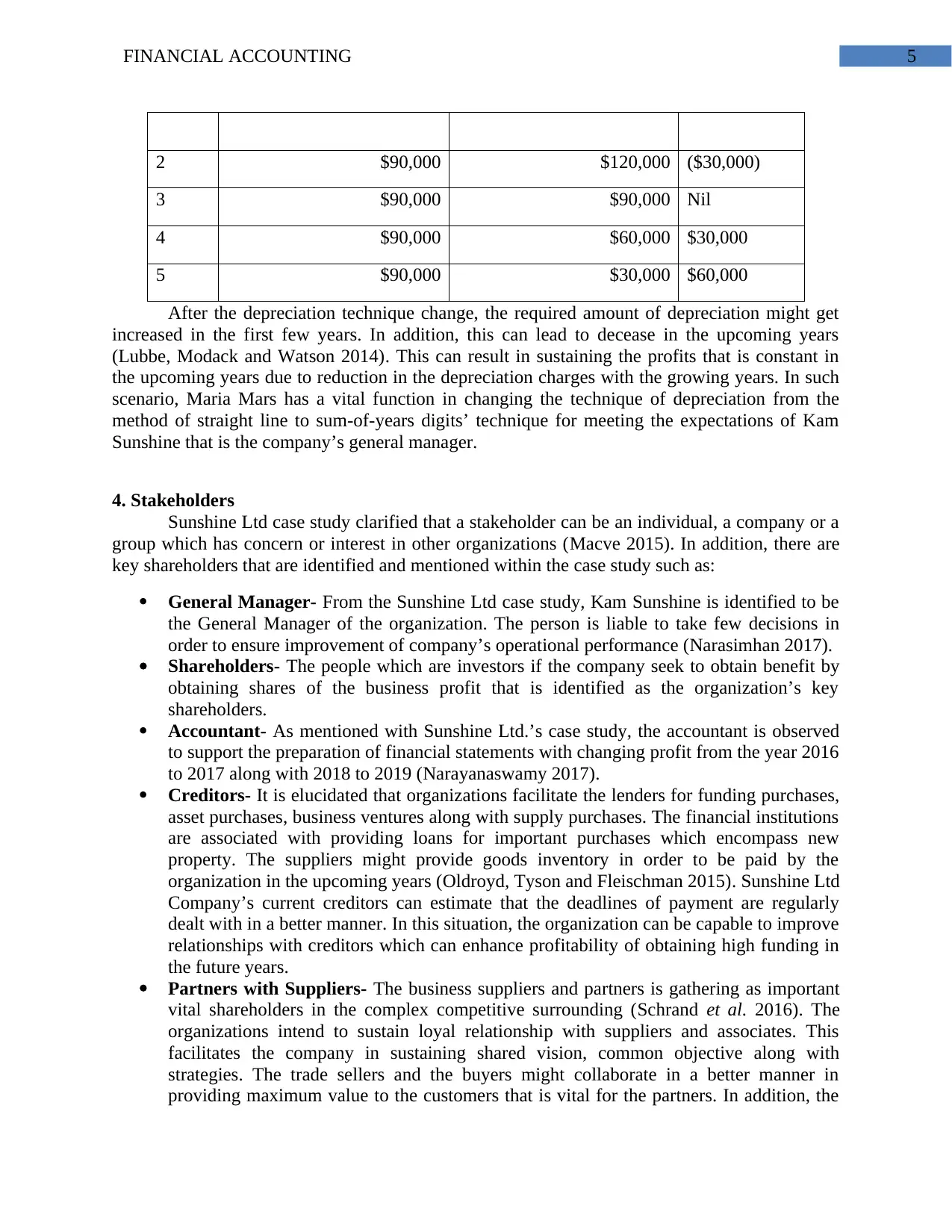
FINANCIAL ACCOUNTING 5
2 $90,000 $120,000 ($30,000)
3 $90,000 $90,000 Nil
4 $90,000 $60,000 $30,000
5 $90,000 $30,000 $60,000
After the depreciation technique change, the required amount of depreciation might get
increased in the first few years. In addition, this can lead to decease in the upcoming years
(Lubbe, Modack and Watson 2014). This can result in sustaining the profits that is constant in
the upcoming years due to reduction in the depreciation charges with the growing years. In such
scenario, Maria Mars has a vital function in changing the technique of depreciation from the
method of straight line to sum-of-years digits’ technique for meeting the expectations of Kam
Sunshine that is the company’s general manager.
4. Stakeholders
Sunshine Ltd case study clarified that a stakeholder can be an individual, a company or a
group which has concern or interest in other organizations (Macve 2015). In addition, there are
key shareholders that are identified and mentioned within the case study such as:
General Manager- From the Sunshine Ltd case study, Kam Sunshine is identified to be
the General Manager of the organization. The person is liable to take few decisions in
order to ensure improvement of company’s operational performance (Narasimhan 2017).
Shareholders- The people which are investors if the company seek to obtain benefit by
obtaining shares of the business profit that is identified as the organization’s key
shareholders.
Accountant- As mentioned with Sunshine Ltd.’s case study, the accountant is observed
to support the preparation of financial statements with changing profit from the year 2016
to 2017 along with 2018 to 2019 (Narayanaswamy 2017).
Creditors- It is elucidated that organizations facilitate the lenders for funding purchases,
asset purchases, business ventures along with supply purchases. The financial institutions
are associated with providing loans for important purchases which encompass new
property. The suppliers might provide goods inventory in order to be paid by the
organization in the upcoming years (Oldroyd, Tyson and Fleischman 2015). Sunshine Ltd
Company’s current creditors can estimate that the deadlines of payment are regularly
dealt with in a better manner. In this situation, the organization can be capable to improve
relationships with creditors which can enhance profitability of obtaining high funding in
the future years.
Partners with Suppliers- The business suppliers and partners is gathering as important
vital shareholders in the complex competitive surrounding (Schrand et al. 2016). The
organizations intend to sustain loyal relationship with suppliers and associates. This
facilitates the company in sustaining shared vision, common objective along with
strategies. The trade sellers and the buyers might collaborate in a better manner in
providing maximum value to the customers that is vital for the partners. In addition, the
2 $90,000 $120,000 ($30,000)
3 $90,000 $90,000 Nil
4 $90,000 $60,000 $30,000
5 $90,000 $30,000 $60,000
After the depreciation technique change, the required amount of depreciation might get
increased in the first few years. In addition, this can lead to decease in the upcoming years
(Lubbe, Modack and Watson 2014). This can result in sustaining the profits that is constant in
the upcoming years due to reduction in the depreciation charges with the growing years. In such
scenario, Maria Mars has a vital function in changing the technique of depreciation from the
method of straight line to sum-of-years digits’ technique for meeting the expectations of Kam
Sunshine that is the company’s general manager.
4. Stakeholders
Sunshine Ltd case study clarified that a stakeholder can be an individual, a company or a
group which has concern or interest in other organizations (Macve 2015). In addition, there are
key shareholders that are identified and mentioned within the case study such as:
General Manager- From the Sunshine Ltd case study, Kam Sunshine is identified to be
the General Manager of the organization. The person is liable to take few decisions in
order to ensure improvement of company’s operational performance (Narasimhan 2017).
Shareholders- The people which are investors if the company seek to obtain benefit by
obtaining shares of the business profit that is identified as the organization’s key
shareholders.
Accountant- As mentioned with Sunshine Ltd.’s case study, the accountant is observed
to support the preparation of financial statements with changing profit from the year 2016
to 2017 along with 2018 to 2019 (Narayanaswamy 2017).
Creditors- It is elucidated that organizations facilitate the lenders for funding purchases,
asset purchases, business ventures along with supply purchases. The financial institutions
are associated with providing loans for important purchases which encompass new
property. The suppliers might provide goods inventory in order to be paid by the
organization in the upcoming years (Oldroyd, Tyson and Fleischman 2015). Sunshine Ltd
Company’s current creditors can estimate that the deadlines of payment are regularly
dealt with in a better manner. In this situation, the organization can be capable to improve
relationships with creditors which can enhance profitability of obtaining high funding in
the future years.
Partners with Suppliers- The business suppliers and partners is gathering as important
vital shareholders in the complex competitive surrounding (Schrand et al. 2016). The
organizations intend to sustain loyal relationship with suppliers and associates. This
facilitates the company in sustaining shared vision, common objective along with
strategies. The trade sellers and the buyers might collaborate in a better manner in
providing maximum value to the customers that is vital for the partners. In addition, the
⊘ This is a preview!⊘
Do you want full access?
Subscribe today to unlock all pages.

Trusted by 1+ million students worldwide
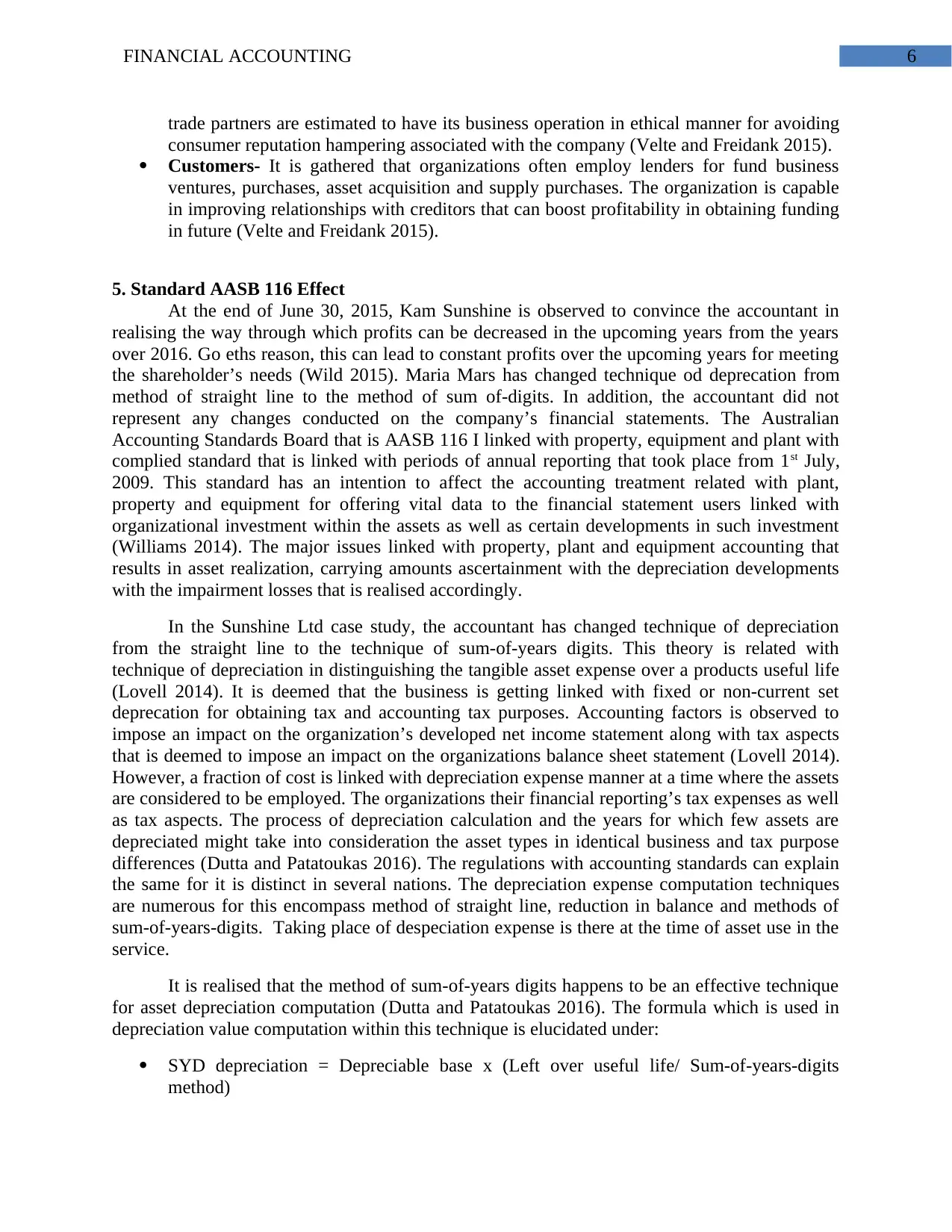
FINANCIAL ACCOUNTING 6
trade partners are estimated to have its business operation in ethical manner for avoiding
consumer reputation hampering associated with the company (Velte and Freidank 2015).
Customers- It is gathered that organizations often employ lenders for fund business
ventures, purchases, asset acquisition and supply purchases. The organization is capable
in improving relationships with creditors that can boost profitability in obtaining funding
in future (Velte and Freidank 2015).
5. Standard AASB 116 Effect
At the end of June 30, 2015, Kam Sunshine is observed to convince the accountant in
realising the way through which profits can be decreased in the upcoming years from the years
over 2016. Go eths reason, this can lead to constant profits over the upcoming years for meeting
the shareholder’s needs (Wild 2015). Maria Mars has changed technique od deprecation from
method of straight line to the method of sum of-digits. In addition, the accountant did not
represent any changes conducted on the company’s financial statements. The Australian
Accounting Standards Board that is AASB 116 I linked with property, equipment and plant with
complied standard that is linked with periods of annual reporting that took place from 1st July,
2009. This standard has an intention to affect the accounting treatment related with plant,
property and equipment for offering vital data to the financial statement users linked with
organizational investment within the assets as well as certain developments in such investment
(Williams 2014). The major issues linked with property, plant and equipment accounting that
results in asset realization, carrying amounts ascertainment with the depreciation developments
with the impairment losses that is realised accordingly.
In the Sunshine Ltd case study, the accountant has changed technique of depreciation
from the straight line to the technique of sum-of-years digits. This theory is related with
technique of depreciation in distinguishing the tangible asset expense over a products useful life
(Lovell 2014). It is deemed that the business is getting linked with fixed or non-current set
deprecation for obtaining tax and accounting tax purposes. Accounting factors is observed to
impose an impact on the organization’s developed net income statement along with tax aspects
that is deemed to impose an impact on the organizations balance sheet statement (Lovell 2014).
However, a fraction of cost is linked with depreciation expense manner at a time where the assets
are considered to be employed. The organizations their financial reporting’s tax expenses as well
as tax aspects. The process of depreciation calculation and the years for which few assets are
depreciated might take into consideration the asset types in identical business and tax purpose
differences (Dutta and Patatoukas 2016). The regulations with accounting standards can explain
the same for it is distinct in several nations. The depreciation expense computation techniques
are numerous for this encompass method of straight line, reduction in balance and methods of
sum-of-years-digits. Taking place of despeciation expense is there at the time of asset use in the
service.
It is realised that the method of sum-of-years digits happens to be an effective technique
for asset depreciation computation (Dutta and Patatoukas 2016). The formula which is used in
depreciation value computation within this technique is elucidated under:
SYD depreciation = Depreciable base x (Left over useful life/ Sum-of-years-digits
method)
trade partners are estimated to have its business operation in ethical manner for avoiding
consumer reputation hampering associated with the company (Velte and Freidank 2015).
Customers- It is gathered that organizations often employ lenders for fund business
ventures, purchases, asset acquisition and supply purchases. The organization is capable
in improving relationships with creditors that can boost profitability in obtaining funding
in future (Velte and Freidank 2015).
5. Standard AASB 116 Effect
At the end of June 30, 2015, Kam Sunshine is observed to convince the accountant in
realising the way through which profits can be decreased in the upcoming years from the years
over 2016. Go eths reason, this can lead to constant profits over the upcoming years for meeting
the shareholder’s needs (Wild 2015). Maria Mars has changed technique od deprecation from
method of straight line to the method of sum of-digits. In addition, the accountant did not
represent any changes conducted on the company’s financial statements. The Australian
Accounting Standards Board that is AASB 116 I linked with property, equipment and plant with
complied standard that is linked with periods of annual reporting that took place from 1st July,
2009. This standard has an intention to affect the accounting treatment related with plant,
property and equipment for offering vital data to the financial statement users linked with
organizational investment within the assets as well as certain developments in such investment
(Williams 2014). The major issues linked with property, plant and equipment accounting that
results in asset realization, carrying amounts ascertainment with the depreciation developments
with the impairment losses that is realised accordingly.
In the Sunshine Ltd case study, the accountant has changed technique of depreciation
from the straight line to the technique of sum-of-years digits. This theory is related with
technique of depreciation in distinguishing the tangible asset expense over a products useful life
(Lovell 2014). It is deemed that the business is getting linked with fixed or non-current set
deprecation for obtaining tax and accounting tax purposes. Accounting factors is observed to
impose an impact on the organization’s developed net income statement along with tax aspects
that is deemed to impose an impact on the organizations balance sheet statement (Lovell 2014).
However, a fraction of cost is linked with depreciation expense manner at a time where the assets
are considered to be employed. The organizations their financial reporting’s tax expenses as well
as tax aspects. The process of depreciation calculation and the years for which few assets are
depreciated might take into consideration the asset types in identical business and tax purpose
differences (Dutta and Patatoukas 2016). The regulations with accounting standards can explain
the same for it is distinct in several nations. The depreciation expense computation techniques
are numerous for this encompass method of straight line, reduction in balance and methods of
sum-of-years-digits. Taking place of despeciation expense is there at the time of asset use in the
service.
It is realised that the method of sum-of-years digits happens to be an effective technique
for asset depreciation computation (Dutta and Patatoukas 2016). The formula which is used in
depreciation value computation within this technique is elucidated under:
SYD depreciation = Depreciable base x (Left over useful life/ Sum-of-years-digits
method)
Paraphrase This Document
Need a fresh take? Get an instant paraphrase of this document with our AI Paraphraser
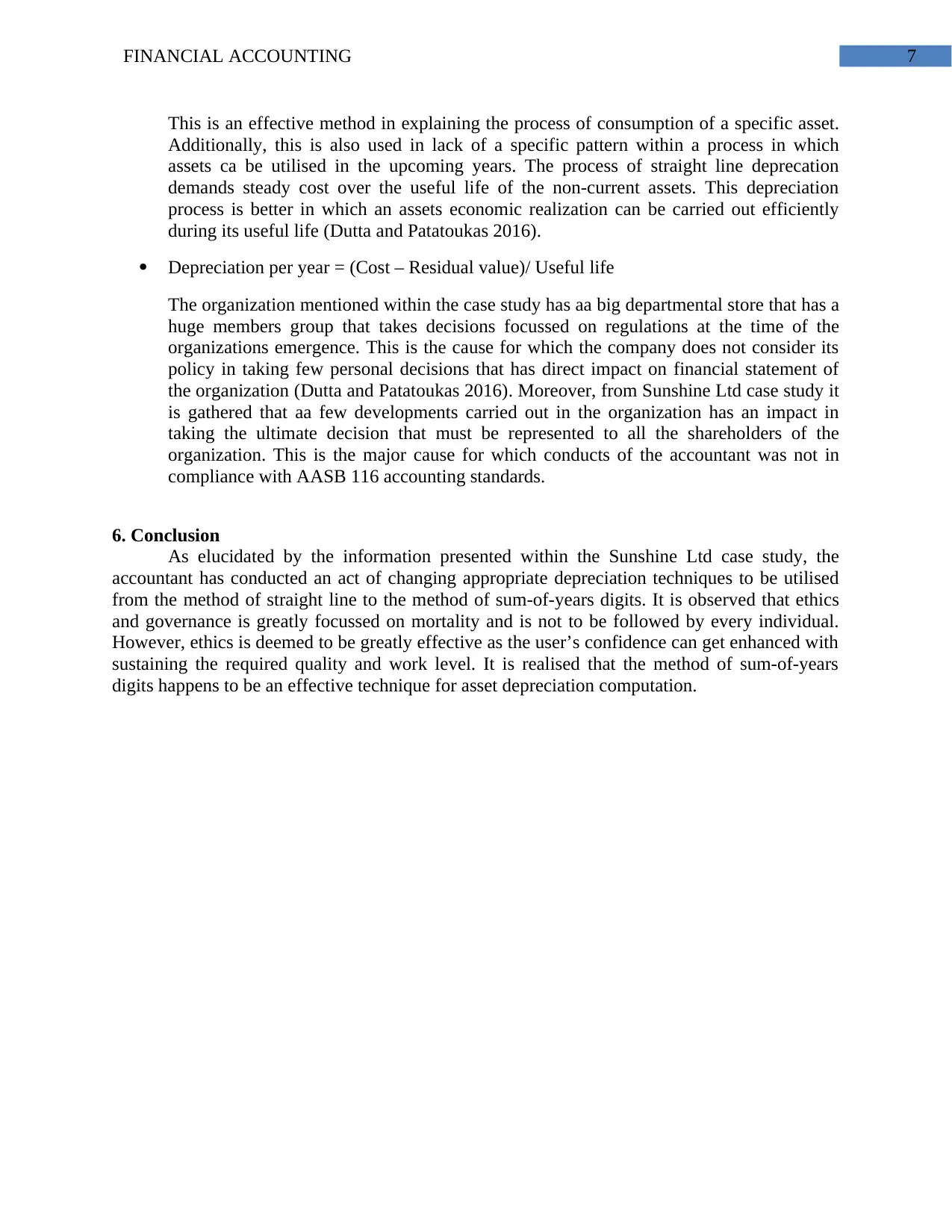
FINANCIAL ACCOUNTING 7
This is an effective method in explaining the process of consumption of a specific asset.
Additionally, this is also used in lack of a specific pattern within a process in which
assets ca be utilised in the upcoming years. The process of straight line deprecation
demands steady cost over the useful life of the non-current assets. This depreciation
process is better in which an assets economic realization can be carried out efficiently
during its useful life (Dutta and Patatoukas 2016).
Depreciation per year = (Cost – Residual value)/ Useful life
The organization mentioned within the case study has aa big departmental store that has a
huge members group that takes decisions focussed on regulations at the time of the
organizations emergence. This is the cause for which the company does not consider its
policy in taking few personal decisions that has direct impact on financial statement of
the organization (Dutta and Patatoukas 2016). Moreover, from Sunshine Ltd case study it
is gathered that aa few developments carried out in the organization has an impact in
taking the ultimate decision that must be represented to all the shareholders of the
organization. This is the major cause for which conducts of the accountant was not in
compliance with AASB 116 accounting standards.
6. Conclusion
As elucidated by the information presented within the Sunshine Ltd case study, the
accountant has conducted an act of changing appropriate depreciation techniques to be utilised
from the method of straight line to the method of sum-of-years digits. It is observed that ethics
and governance is greatly focussed on mortality and is not to be followed by every individual.
However, ethics is deemed to be greatly effective as the user’s confidence can get enhanced with
sustaining the required quality and work level. It is realised that the method of sum-of-years
digits happens to be an effective technique for asset depreciation computation.
This is an effective method in explaining the process of consumption of a specific asset.
Additionally, this is also used in lack of a specific pattern within a process in which
assets ca be utilised in the upcoming years. The process of straight line deprecation
demands steady cost over the useful life of the non-current assets. This depreciation
process is better in which an assets economic realization can be carried out efficiently
during its useful life (Dutta and Patatoukas 2016).
Depreciation per year = (Cost – Residual value)/ Useful life
The organization mentioned within the case study has aa big departmental store that has a
huge members group that takes decisions focussed on regulations at the time of the
organizations emergence. This is the cause for which the company does not consider its
policy in taking few personal decisions that has direct impact on financial statement of
the organization (Dutta and Patatoukas 2016). Moreover, from Sunshine Ltd case study it
is gathered that aa few developments carried out in the organization has an impact in
taking the ultimate decision that must be represented to all the shareholders of the
organization. This is the major cause for which conducts of the accountant was not in
compliance with AASB 116 accounting standards.
6. Conclusion
As elucidated by the information presented within the Sunshine Ltd case study, the
accountant has conducted an act of changing appropriate depreciation techniques to be utilised
from the method of straight line to the method of sum-of-years digits. It is observed that ethics
and governance is greatly focussed on mortality and is not to be followed by every individual.
However, ethics is deemed to be greatly effective as the user’s confidence can get enhanced with
sustaining the required quality and work level. It is realised that the method of sum-of-years
digits happens to be an effective technique for asset depreciation computation.
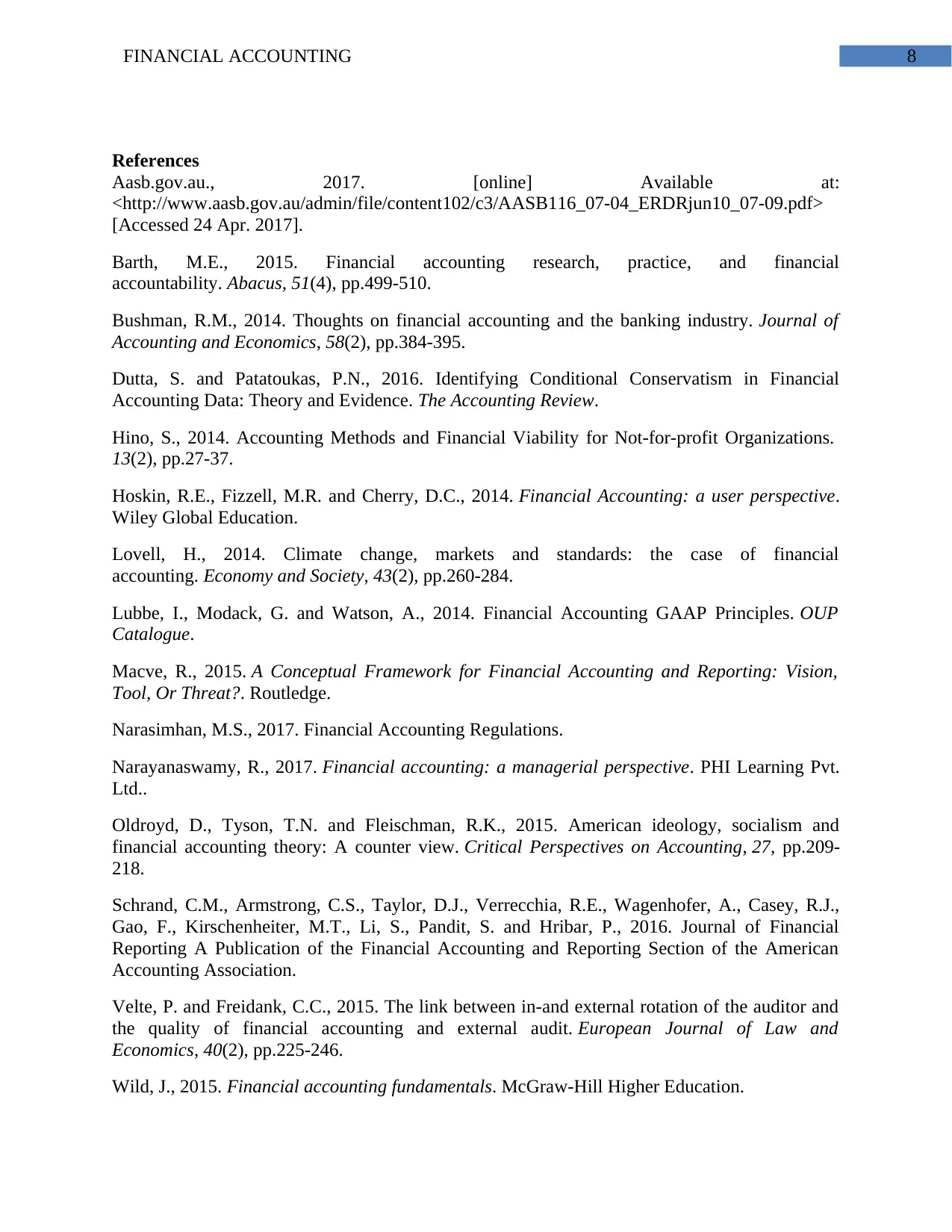
FINANCIAL ACCOUNTING 8
References
Aasb.gov.au., 2017. [online] Available at:
<http://www.aasb.gov.au/admin/file/content102/c3/AASB116_07-04_ERDRjun10_07-09.pdf>
[Accessed 24 Apr. 2017].
Barth, M.E., 2015. Financial accounting research, practice, and financial
accountability. Abacus, 51(4), pp.499-510.
Bushman, R.M., 2014. Thoughts on financial accounting and the banking industry. Journal of
Accounting and Economics, 58(2), pp.384-395.
Dutta, S. and Patatoukas, P.N., 2016. Identifying Conditional Conservatism in Financial
Accounting Data: Theory and Evidence. The Accounting Review.
Hino, S., 2014. Accounting Methods and Financial Viability for Not-for-profit Organizations.
13(2), pp.27-37.
Hoskin, R.E., Fizzell, M.R. and Cherry, D.C., 2014. Financial Accounting: a user perspective.
Wiley Global Education.
Lovell, H., 2014. Climate change, markets and standards: the case of financial
accounting. Economy and Society, 43(2), pp.260-284.
Lubbe, I., Modack, G. and Watson, A., 2014. Financial Accounting GAAP Principles. OUP
Catalogue.
Macve, R., 2015. A Conceptual Framework for Financial Accounting and Reporting: Vision,
Tool, Or Threat?. Routledge.
Narasimhan, M.S., 2017. Financial Accounting Regulations.
Narayanaswamy, R., 2017. Financial accounting: a managerial perspective. PHI Learning Pvt.
Ltd..
Oldroyd, D., Tyson, T.N. and Fleischman, R.K., 2015. American ideology, socialism and
financial accounting theory: A counter view. Critical Perspectives on Accounting, 27, pp.209-
218.
Schrand, C.M., Armstrong, C.S., Taylor, D.J., Verrecchia, R.E., Wagenhofer, A., Casey, R.J.,
Gao, F., Kirschenheiter, M.T., Li, S., Pandit, S. and Hribar, P., 2016. Journal of Financial
Reporting A Publication of the Financial Accounting and Reporting Section of the American
Accounting Association.
Velte, P. and Freidank, C.C., 2015. The link between in-and external rotation of the auditor and
the quality of financial accounting and external audit. European Journal of Law and
Economics, 40(2), pp.225-246.
Wild, J., 2015. Financial accounting fundamentals. McGraw-Hill Higher Education.
References
Aasb.gov.au., 2017. [online] Available at:
<http://www.aasb.gov.au/admin/file/content102/c3/AASB116_07-04_ERDRjun10_07-09.pdf>
[Accessed 24 Apr. 2017].
Barth, M.E., 2015. Financial accounting research, practice, and financial
accountability. Abacus, 51(4), pp.499-510.
Bushman, R.M., 2014. Thoughts on financial accounting and the banking industry. Journal of
Accounting and Economics, 58(2), pp.384-395.
Dutta, S. and Patatoukas, P.N., 2016. Identifying Conditional Conservatism in Financial
Accounting Data: Theory and Evidence. The Accounting Review.
Hino, S., 2014. Accounting Methods and Financial Viability for Not-for-profit Organizations.
13(2), pp.27-37.
Hoskin, R.E., Fizzell, M.R. and Cherry, D.C., 2014. Financial Accounting: a user perspective.
Wiley Global Education.
Lovell, H., 2014. Climate change, markets and standards: the case of financial
accounting. Economy and Society, 43(2), pp.260-284.
Lubbe, I., Modack, G. and Watson, A., 2014. Financial Accounting GAAP Principles. OUP
Catalogue.
Macve, R., 2015. A Conceptual Framework for Financial Accounting and Reporting: Vision,
Tool, Or Threat?. Routledge.
Narasimhan, M.S., 2017. Financial Accounting Regulations.
Narayanaswamy, R., 2017. Financial accounting: a managerial perspective. PHI Learning Pvt.
Ltd..
Oldroyd, D., Tyson, T.N. and Fleischman, R.K., 2015. American ideology, socialism and
financial accounting theory: A counter view. Critical Perspectives on Accounting, 27, pp.209-
218.
Schrand, C.M., Armstrong, C.S., Taylor, D.J., Verrecchia, R.E., Wagenhofer, A., Casey, R.J.,
Gao, F., Kirschenheiter, M.T., Li, S., Pandit, S. and Hribar, P., 2016. Journal of Financial
Reporting A Publication of the Financial Accounting and Reporting Section of the American
Accounting Association.
Velte, P. and Freidank, C.C., 2015. The link between in-and external rotation of the auditor and
the quality of financial accounting and external audit. European Journal of Law and
Economics, 40(2), pp.225-246.
Wild, J., 2015. Financial accounting fundamentals. McGraw-Hill Higher Education.
⊘ This is a preview!⊘
Do you want full access?
Subscribe today to unlock all pages.

Trusted by 1+ million students worldwide
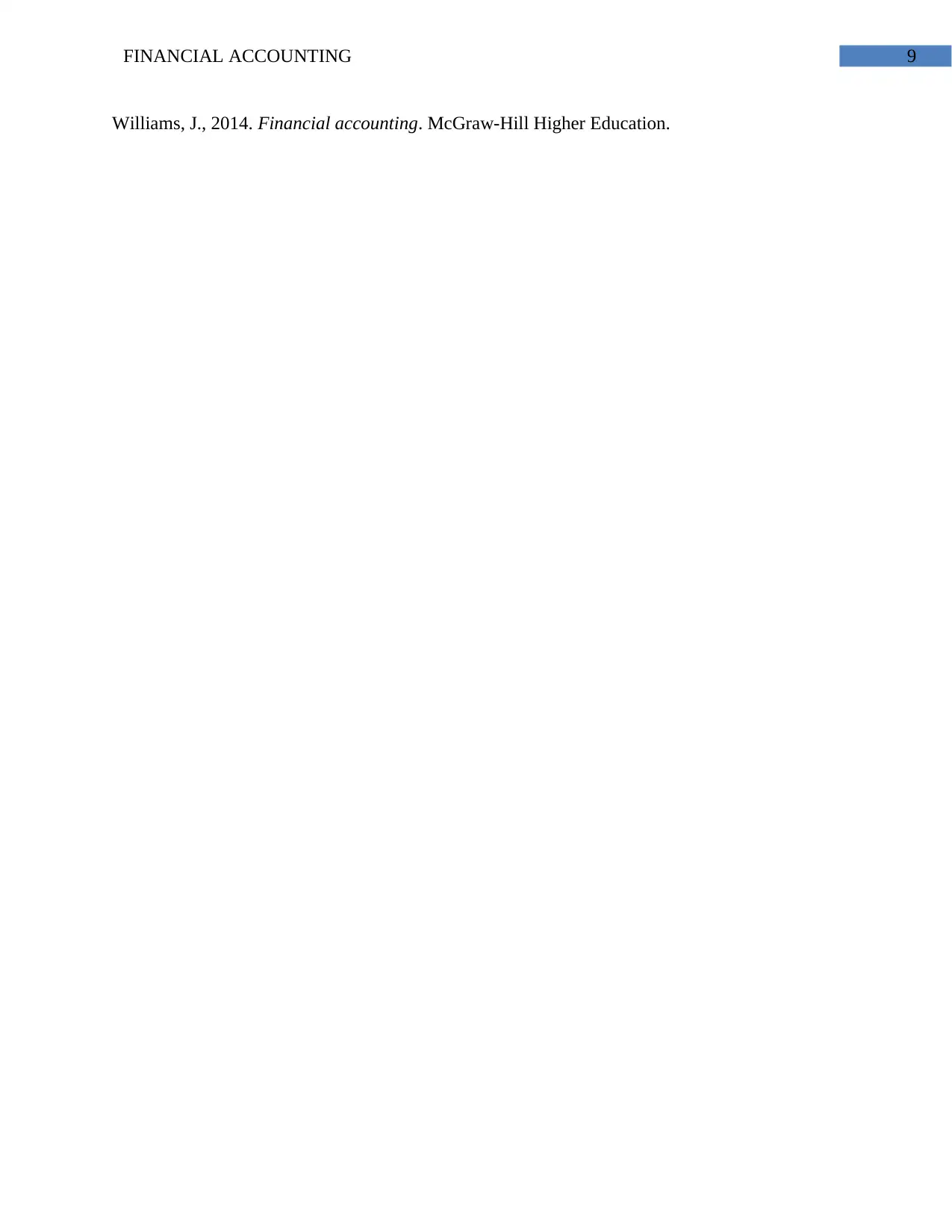
FINANCIAL ACCOUNTING 9
Williams, J., 2014. Financial accounting. McGraw-Hill Higher Education.
Williams, J., 2014. Financial accounting. McGraw-Hill Higher Education.
1 out of 10
Related Documents
Your All-in-One AI-Powered Toolkit for Academic Success.
+13062052269
info@desklib.com
Available 24*7 on WhatsApp / Email
![[object Object]](/_next/static/media/star-bottom.7253800d.svg)
Unlock your academic potential
Copyright © 2020–2025 A2Z Services. All Rights Reserved. Developed and managed by ZUCOL.





